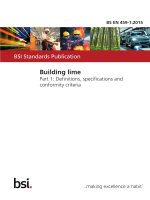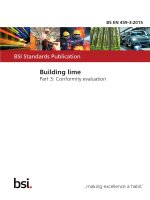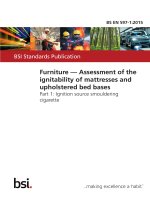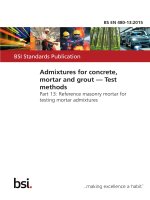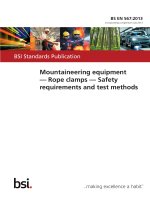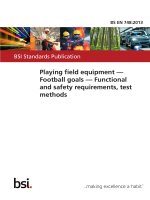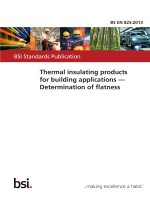Bsi bs en 61472 2013 (2015)
Bạn đang xem bản rút gọn của tài liệu. Xem và tải ngay bản đầy đủ của tài liệu tại đây (1.54 MB, 48 trang )
BS EN 61472:2013
Incorporating corrigendum October 2015
BSI Standards Publication
Live working — Minimum
approach distances for
a.c systems in the voltage
range 72,5 kV to 800 kV —
A method of calculation
BRITISH STANDARD
BS EN 61472:2013
National foreword
This British Standard is the UK implementation of EN 61472:2013. It is
identical to IEC 61472:2013, incorporating corrigendum October
2015. It supersedes BS EN 61472:2004, which will be withdrawn
on 16 May 2016.
The start and finish of text introduced or altered by corrigendum
is indicated in the text by tags. Text altered by IEC corrigendum
October 2015 is indicated in the text by ˆ‰.
The UK participation in its preparation was entrusted to Technical
Committee PEL/78, Tools for live working.
A list of organizations represented on this committee can be obtained on
request to its secretary.
This publication does not purport to include all the necessary provisions of
a contract. Users are responsible for its correct application.
© The British Standards Institution 2016.
Published by BSI Standards Limited 2016
ISBN 978 0 580 92887 1
ICS 13.260; 29.240.20; 29.260.99
Compliance with a British Standard cannot confer immunity from
legal obligations.
This British Standard was published under the authority of the
Standards Policy and Strategy Committee on 31 July 2013.
Amendments/corrigenda issued since publication
Date
Text affected
31 March 2016
Implementation of IEC corrigendum October 2015
EN 61472
EUROPEAN STANDARD
NORME EUROPÉENNE
EUROPÄISCHE NORM
July 2013
ICS 13.260; 29.240.20; 29.260.99
Supersedes EN 61472:2004
English version
Live working Minimum approach distances for a.c systems in the voltage range
72,5 kV to 800 kV A method of calculation
(IEC 61472:2013)
Travaux sous tension Distances minimales d'approche pour des
réseaux à courant alternatif de tension
comprise entre 72,5 kV et 800 kV Une méthode de calcul
(CEI 61472:2013)
Arbeiten unter Spannung Mindest-Arbeitsabstände für
Wechselspannungsnetze im
Spannungsbereich
von 72,5 kV bis 800 kV Berechnungsverfahren
(IEC 61472:2013)
This European Standard was approved by CENELEC on 2013-05-16. CENELEC members are bound to comply
with the CEN/CENELEC Internal Regulations which stipulate the conditions for giving this European Standard
the status of a national standard without any alteration.
Up-to-date lists and bibliographical references concerning such national standards may be obtained on
application to the CEN-CENELEC Management Centre or to any CENELEC member.
This European Standard exists in three official versions (English, French, German). A version in any other
language made by translation under the responsibility of a CENELEC member into its own language and notified
to the CEN-CENELEC Management Centre has the same status as the official versions.
CENELEC members are the national electrotechnical committees of Austria, Belgium, Bulgaria, Croatia, Cyprus,
the Czech Republic, Denmark, Estonia, Finland, Former Yugoslav Republic of Macedonia, France, Germany,
Greece, Hungary, Iceland, Ireland, Italy, Latvia, Lithuania, Luxembourg, Malta, the Netherlands, Norway, Poland,
Portugal, Romania, Slovakia, Slovenia, Spain, Sweden, Switzerland, Turkey and the United Kingdom.
CENELEC
European Committee for Electrotechnical Standardization
Comité Européen de Normalisation Electrotechnique
Europäisches Komitee für Elektrotechnische Normung
Management Centre: Avenue Marnix 17, B - 1000 Brussels
© 2013 CENELEC -
All rights of exploitation in any form and by any means reserved worldwide for CENELEC members.
Ref. No. EN 61472:2013 E
BS EN 61472:2013
EN 61472:2013
Foreword
The text of document 78/1004/FDIS, future edition 3 of IEC 61472, prepared by IEC/TC 78 "Live working"
was submitted to the IEC-CENELEC parallel vote and approved by CENELEC as EN 61472:2013.
The following dates are fixed:
•
•
latest date by which the document has
to be implemented at national level by
publication of an identical national
standard or by endorsement
latest date by which the national
standards conflicting with the
document have to be withdrawn
(dop)
2014-02-16
(dow)
2016-05-16
This document supersedes EN 61472:2004.
This document has been prepared according to the requirements of EN 61477: Live working – Minimum
requirements for the utilization of tools, devices and equipment, where applicable.
EN 61472:2013 includes the following significant technical changes with respect to EN 61472:2004:
– clarification of the scope;
– review of the definitions;
– clarification of the methodology of determining whether live working is permissible and the calculation of
the minimum approach distances;
– modification of the basic equation for calculation of the minimum approach distance;
– introduction of Table 1 for altitude correction factor simplification ka;
– introduction of criteria in presence of composite insulator and clarification on the use of insulator factor
k i;
– review of the informative Annex F on the influence of floating conductive objects on the dielectric
strength;
– review of the informative Annex G on live working near contaminated, damaged or moist insulation.
Attention is drawn to the possibility that some of the elements of this document may be the subject of
patent rights. CENELEC [and/or CEN] shall not be held responsible for identifying any or all such patent
rights.
Endorsement notice
The text of the International Standard IEC 61472:2013 was approved by CENELEC as a European
Standard without any modification.
In the official version, for Bibliography, the following notes have to be added for the standards indicated:
IEC 60060-1:2010
NOTE Harmonised as EN 60060-1:2010 (not modified).
IEC 60071-1:2006
NOTE Harmonised as EN 60071-1:2006 (not modified).
IEC 60071-2:1996
NOTE Harmonised as EN 60071-2:1997 (not modified).
IEC 60743
NOTE Harmonised as EN 60743.
IEC 61477:2009
NOTE Harmonised as EN 61477:2009 (not modified).
–2–
BS EN 61472:2013
61472 © IEC:2013
CONTENTS
1
Scope ............................................................................................................................... 6
2
Terms, definitions and symbols ........................................................................................ 6
3
2.1 Terms and definitions .............................................................................................. 6
2.2 Symbols used in the normative part of the document ............................................... 8
Methodology ..................................................................................................................... 9
4
Factors influencing calculations ...................................................................................... 10
4.1
4.2
4.3
5
Statistical overvoltage ........................................................................................... 10
Gap strength ......................................................................................................... 10
Calculation of electrical distance D U ..................................................................... 11
4.3.1 General equation ....................................................................................... 11
4.3.2 Factors affecting gap strength ................................................................... 11
Evaluation of risks .......................................................................................................... 16
Calculation of minimum approach distance D A ............................................................... 17
Annex A (informative) Ergonomic distance ........................................................................... 18
6
Annex B (informative) Overvoltages ..................................................................................... 20
Annex C (informative) Dielectric strength of air .................................................................... 24
Annex D (informative) Gap factor k g .................................................................................... 26
Annex E (informative) Allowing for atmospheric conditions .................................................. 28
Annex F (informative) Influence of floating conductive objects on the dielectric
strength ................................................................................................................................ 32
Annex G (informative) Live working near contaminated, damaged or moist insulation .......... 40
Bibliography .......................................................................................................................... 45
Figure 1 – Illustration of two floating conductive objects of different dimensions and at
different distances from the axis of the gap ........................................................................... 13
Figure 2 – Typical live working tasks ..................................................................................... 15
Figure B.1 – Ranges of u e2 at the open ended line due to closing and reclosing
according to the type of network (meshed or antenna) with and without closing
resistors and shunt reactors .................................................................................................. 22
Figure F.1 – Influence of the length of the floating conductive objects – phase to earth
rod-rod configuration – 250 µs /2 500 µs impulse .................................................................. 35
Figure F.2 – Influence of the length of the floating conductive objects – phase to phase
conductor-conductor configuration – 250 µs /2 500 µs impulse ............................................. 36
Figure F.3 – Reduction of the dielectric strength as a function of the length D for
constant values of β – Phase to earth rod-rod configuration .................................................. 37
Figure F.4 – Reduction of the dielectric strength as a function of the length P for
constant values of β – Phase to phase conductor-conductor configuration ............................ 37
Figure G.1 – Strength of composite insulators affected by simulated conductive and
semi-conductive defects ....................................................................................................... 43
Table 1 – Average k a values ................................................................................................. 12
Table 2 – Floating conductive object factor k f ....................................................................... 14
Table B.1 – Classification of overvoltages according to IEC 60071-1 .................................... 20
BS EN 61472:2013
61472 © IEC:2013
–3–
Table D.1 – Gap factors for some actual phase to earth configurations ................................. 27
Table E.1 – Atmospheric factor k a for different reference altitudes and values of U 90 ........... 30
Table G.1 – Example of maximum number of damaged insulators calculation (gap
factor 1,4) ............................................................................................................................. 41
Table G.2 – Example of maximum number of damaged insulators calculation (gap
factor 1,2) ............................................................................................................................. 42
–6–
BS EN 61472:2013
61472 © IEC:2013
LIVE WORKING –
MINIMUM APPROACH DISTANCES FOR A.C. SYSTEMS
IN THE VOLTAGE RANGE 72,5 kV TO 800 kV –
A METHOD OF CALCULATION
1
Scope
This International Standard describes a method for calculating the minimum approach
distances for live working, at maximum voltages between 72,5 kV and 800 kV. This standard
addresses system overvoltages and the working air distances or tool insulation between parts
and/or workers at different electric potentials.
The required withstand voltage and minimum approach distances calculated by the method
described in this standard are evaluated taking into consideration the following:
–
workers are trained for, and skilled in, working in the live working zone;
–
the anticipated overvoltages do not exceed the value selected for the determination of the
required minimum approach distance;
–
transient overvoltages are the determining overvoltages;
–
tool insulation has no continuous film of moisture or measurable contamination present on
the surface;
–
no lightning is seen or heard within 10 km of the work site;
–
allowance is made for the effect of conducting components of tools;
–
the effect of altitude, insulators in the gap, etc, on the electric strength is taken into
consideration.
For conditions other than the above, the evaluation of the minimum approach distances may
require specific data, derived by other calculation or obtained from additional laboratory
investigations on the actual situation.
2
Terms, definitions and symbols
For the purpose of this document, the following terms, definitions and symbols apply.
2.1
Terms and definitions
2.1.1
damaged insulator
insulator having any type of manufacturing defect or in-service deterioration which affects its
insulating performance
2.1.2
electrical distance
DU
distance in air required to prevent a disruptive discharge between energized parts or between
energized parts and earthed parts during live working
[SOURCE: IEC 60050-651:–, 651-21-12]
BS EN 61472:2013
61472 © IEC:2013
–7–
2.1.3
ergonomic distance
ergonomic component of distance
DE
distance in air added to the electrical distance, to take into account inadvertent movement
and errors in judgement of distances while performing work
[SOURCE: IEC 60050-651:–, 651-21-13]
2.1.4
fifty per cent disruptive discharge voltage
U 50
peak value of an impulse test voltage having a fifty per cent probability of initiating a
disruptive discharge each time the dielectric testing is performed
[SOURCE: IEC 60050-604:1987, 604-03-43]
2.1.5
highest voltage of a system
Us
highest value of operating voltage which occurs under normal operating conditions at any time
and any point in the system (phase to phase voltage)
Note 1 to entry: Transient overvoltages due e.g. to switching operations and abnormal temporary variations of
voltage are not taken into account.
[SOURCE: IEC 60050-601:1985, 601-01-23, modified – A reference to phase to phase voltage
has been added.]
2.1.6
minimum approach distance
minimum working distance
DA
minimum distance in air to be maintained between any part of the body of a worker, including
any object (except tools appropriate for live working) being handled directly, and any part(s)
at different electric potential(s)
Note 1 to entry: The minimum approach distance is the sum of the electrical distance appropriate for the
maximum nominal voltage and of the selected ergonomic distance.
[SOURCE: IEC 60050-651:–, 651-21-11]
2.1.7
minimum residual insulation length
D Lins
insulation length required to prevent a disruptive discharge between energized parts and
earthed parts measured along the insulator length, taking into account the presence of
floating conductive objects and of damaged insulator portions
2.1.8
ninety per cent statistical impulse withstand voltage
U 90
peak value of an impulse test voltage at which insulation exhibits, under specified conditions,
a ninety per cent probability of withstand
Note 1 to entry:
This concept is applicable to self-restoring insulation.
[SOURCE: IEC 60050-604:1987, 604-03-42, modified – The definition has been changed to
refer specifically to a ninety per cent probability of withstand.]
–8–
BS EN 61472:2013
61472 © IEC:2013
2.1.9
part
any element present in the work location, other than workers, live working tools and system
insulation
2.1.10
per unit value
u
expression of the per unit value of the amplitude of an overvoltage (or of a voltage) referred to
Us 2 / 3
Note 1 to entry:
This applies to u e2 and u p2 defined in Clause 4.
2.1.11
transient overvoltage
short duration overvoltage of few milliseconds or less, oscillatory or non-oscillatory, usually
highly damped
[SOURCE: IEC 60050-604:1987, 604-03-13, modified – The two notes in the original definition
have been deleted.]
2.1.12
two per cent statistical overvoltage
U2
peak value of a transient overvoltage having a 2 per cent statistical probability of being
exceeded
2.1.13
work location
any site, place or area where a work activity is to be, is being, or has been carried out
[SOURCE: IEC 60050-651:–, 651-26-03]
2.2
Symbols used in the normative part of the document
Ad
length of damaged insulator or number of damaged units in an insulator of length A o ,
not shunted by long arcing horn or grading ring
Ao
length of undamaged insulator or number of undamaged insulator units not shunted
by long arcing horn or grading ring
β
ratio of the total length in the direction of the gap axis of the floating conductive
objects (s) to the original air gap length
D
length of the remaining air gap phase to earth
DA
minimum approach distance
DE
ergonomic distance
DU
electrical distance necessary to obtain U 90
D Lins
minimum residual insulation length
d1,
d 3,
F
d 2 , distances between the worker(s) and parts of the installation at different electric
d 4 potentials (see Figure 2)
sum of all lengths, in the direction of the gap axis, of all floating conductive objects
in the air gap (in metres)
BS EN 61472:2013
61472 © IEC:2013
–9–
Ks
statistical safety factor
Kt
factor combining different considerations influencing the strength of the gap
ka
atmospheric factor
kd
coefficient characterizing the average state of the damaged insulators
kf
floating conductive object factor
kg
gap factor
ki
damaged insulator factor
k ic
damaged composite insulator factor
k is
damaged insulator strings factor
ks
standard statistical deviation factor
Lf
original air gap length
P
length of the remaining gap phase to phase
r
distance of a conductive object from the axis of the gap
se
normalized value of the standard deviation of U 50 expressed in per cent
U2
two per cent statistical overvoltage
U 50
fifty per cent disruptive discharge voltage
U 90
ninety per cent statistical impulse withstand voltage
U e2
two per cent statistical overvoltage between phase and earth
U e90
ninety per cent statistical impulse withstand voltage phase to earth
U p2
two per cent statistical overvoltage between two phases
U p90
ninety per cent statistical impulse withstand between two phases
u e2
per unit value of the two per cent statistical overvoltage phase to earth
u p2
per unit value of the two per cent statistical overvoltage between two phases
Us
highest voltage of a system between two phases
3
Methodology
The methodology of determining whether live working is permissible and the calculation of the
minimum approach distances is based on the following considerations:
a) to determine the statistical overvoltage expected in the work location (U 2 ) and from this,
determine the required statistical impulse withstand voltage of the insulation in the work
location (U 90 );
b) to calculate the minimum residual insulation length D Lins if working next to insulators;
c) to calculate the electrical distance D U required for the impulse withstand voltage U 90 ;
d) to add an additional distance to allow for ergonomic factors associated with live working,
such as inadvertent movement.
The minimum approach distance D A is thus determined by:
– 10 –
BS EN 61472:2013
61472 © IEC:2013
D A = DU (K s = 1,0 ) + DE
(1)
where
D U is the electrical distance necessary to obtain U 90 ;
D E is the ergonomic distance and is dependent on work procedures, level of training, skill of
the workers, type of construction, and such contingencies as inadvertent movement, and
errors in appraising distances (see Annex A for details).
Refer to Clause 5 for application of ergonomic distance.
4
Factors influencing calculations
4.1
Statistical overvoltage
The electrical stress at the work location shall be known. The electrical stress is described as
the statistical overvoltage that may be present at the work location. In a three-phase a.c.
power system the statistical overvoltage U e2 between phase and earth is:
U e2 = ( 2/ 3) U s u e2
(2)
where
U s ( 2/ 3) is the highest phase to earth peak voltage, of the system expressed in kV, and
u e2 is the statistical overvoltage phase to earth expressed in per unit.
The statistical overvoltage U p2 between two phases is:
U p2 = ( 2/ 3) U s u p2
(3)
where u p2 is the statistical overvoltage phase to phase expressed in per unit.
If the per unit phase to phase data are not available, an approximate value can be derived
from u e2 by the following formula:
u p2 = 1,35 u e2 + 0,45
(4)
The transient overvoltages to be considered are the maximum that can occur, either on the
installation being worked on or at the work site, whether caused by system faults or by
switching (see Annex B).
4.2
Gap strength
For the determination of the electrical distance, the required withstand voltage for live working
is taken to be equal to the voltage U 90 , determined from the general expression
U 90 = K s U 2
(5)
Considering the phase to earth and phase to phase voltages separately and combining
equation (5) with equations (2) and (3) gives:
U e90 = K s ( 2/ 3) U s u e2
(6)
U p90 = K s ( 2/ 3) U s u p2
(7)
BS EN 61472:2013
61472 © IEC:2013
– 11 –
where
Ks
is the statistical safety factor (1,0 or 1,1 for formula (5), (6) and (7)) (see
Clause 5);
U e90 and U p90 are respectively the statistical impulse withstand voltages phase to earth and
phase to phase, expressed in kV.
4.3
Calculation of electrical distance DU
4.3.1
General equation
The strength of the gap is influenced by a series of considerations which can be combined in
a factor K t used in the following formula for calculating D U (in metres):
ˆ D U = 2,17 (e U 90 /(1 080K t ) – 1) + F ‰
(8)
where
F
sum of all lengths, in the direction of the gap axis, of all floating conductive objects in
the air gap (in metres) (see 4.3.2.4);
U 90
is the phase to earth (U e90 ) or the phase to phase (U p90 ) statistical impulse withstand
voltage in kV;
Kt
is given by:
Kt = ks kg k a kf ki
4.3.2
4.3.2.1
(9)
Factors affecting gap strength
Standard statistical deviation factor k s
Factor k s accounts for the statistical nature of the breakdown voltage. Unless the value of the
standard deviation, s e , is known from tests representing the gap configuration, a value of
0,936, based on a standard deviation of 5 %, for positive impulses, can be used (see
Annex C).
4.3.2.2
Gap factor k g
The gap factor k g takes into account the effect of the gap configuration on the dielectric
strength of air (see Annex D).
NOTE 1 Unless an appropriate gap factor can be selected for the structure configurations that exist at the system
voltage being considered, a generally conservative value that allows for a variety of configurations is k g = 1,2 for
phase to earth and k g = 1,45 for phase to phase.
NOTE 2 CIGRÉ Brochure 72 and IEC 60071-2 provide more information concerning the determination of k g for
various gap configurations.
4.3.2.3
Atmospheric factor k a
The atmospheric factor takes into account the effect of air density. Air density is influenced by
temperature, humidity and altitude. The effect of temperature and humidity is negligible in
comparison with the effect of altitude.
The electric strength of the air insulation in the work location is mainly affected by the altitude
above sea level. This effect, which varies to some extent with the gap length, or conversely
with the withstand voltage, is accounted for by the atmospheric factor k a . The appropriate
value of k a can be selected from Table 1 of average values or from Table E.1 or calculated for
a specific altitude and U 90 by the method given in Annex E, for a reference altitude below
which most live work is done.
BS EN 61472:2013
61472 © IEC:2013
– 12 –
Table 1 – Average k a values
Altitude
m
ka
average
0
1,000
100
0,995
300
0,983
500
0,972
1 000
0,941
1 500
0,909
2 000
0,875
2 500
0,841
3 000
0,805
The electrical distance D U should be increased when live work is carried out in locations
higher than the reference altitude in order to account for the lower mean atmospheric
pressure. This can be done by multiplying D U by an altitude correction factor, which can be
calculated using the equations given in Annex E.
4.3.2.4
Floating conductive object factor k f
Floating conductive objects can decrease, or increase, the electric strength of a gap by field
distortion.
A conductive object placed between two electrodes at different electric potentials, and not
connected to either one, is electrically floating and acquires an intermediate potential. The
extent of the influence these floating conductive objects have on the electric strength of the
gap varies depending on the number of floating conductive objects, their dimensions, shapes
and geometrical positions in the gap. Nevertheless, the presence of the floating conductive
object(s) reduces the net electrical length of the air gap.
When calculating the effects of floating conductive objects, all possible disruptive discharge
paths should be considered in determining the floating conductive object factor k f . The sum of
all floating conductive objects in the direction of the gap axis constitutes the floating
conductive object length, F.
In the most common live line work situations on high voltage lines, the k f factor depends on
the length of the remaining gap and on the lateral distance r of the conductive object from the
axis of the gap (see Figure 1). It has to be pointed out that D is obtained by subtracting the
length F from the original air gap L f , i.e. D = L f − F. Annex F provides evaluation criteria of the
k f factor as a function of F and D (P when phase to phase distances are considered), by
introducing the parameter
β = F (D + F )
(or β = F (P + F ) when phase to phase distances are considered).
Experimental investigations (see Annex F) have shown that, in the more critical cases
representative of live line working configurations, the k f coefficient may be as low as 0,75 for
phase to earth gap distances over 1,2 m.
BS EN 61472:2013
61472 © IEC:2013
– 13 –
IEC 623/13
Figure 1 – Illustration of two floating conductive objects of different dimensions
and at different distances from the axis of the gap
Table 2 reports a simplified criterion for the k f determination in dependence of β and L f . The k f
values are derived from the interpolation of the data shown in Annex F. Table 2 contains the
values of β in function of the original gap length L f rather than in function of the remaining air
gap length D because the original gap length L f is one of the important quantities that
characterise the constructed a.c. system.
For long or flat shaped conductive objects situated perpendicular to the air gap, for which no
specific experimental data exists, a conservative value k f = 0,75 may be assumed.
BS EN 61472:2013
61472 © IEC:2013
– 14 –
Table 2 – Floating conductive object factor k f
Phase to earth gaps
β
Lf
b
0,1
0,15
0,2
0,25
Phase to phase gaps
a
kf
β
Lf a
b
m
kf
m
Over
Up to
Over
Up to
---
0,9
3,9
---
0,9
3,9
---
0,5
4,7
---
0,5
1
3,3
4,7
2,7
---
Over
Up to
Over
Up to
---
0,9
5,7
---
1
0,9
2,1
3,8
5,7
0,95
1
2,1
3,8
0,95
---
0,6
6
0,6
1,6
1,6
2,2
1
0,95
3,3
---
0,9
---
1
4,6
6
0,95
3,6
4,6
0,9
1
1,2
1,2
2,7
---
0,4
4,9
---
1
2,2
3,6
0,4
0,9
3,7
4,9
0,95
---
0,4
6,3
---
1
0,9
1
3,1
3,7
0,9
0,4
1,4
5,1
6,3
0,95
1
1,2
2,6
3,1
0,85
1,4
1,8
4,4
5,1
0,9
1,2
2,6
0,8
1,8
2,3
3,5
4,4
0,85
---
0,3
5,1
---
1
2,3
3,5
0,3
0,8
3,8
5,1
0,95
0,8
0,9
3,2
3,8
0,9
0,9
1,1
2,8
3,2
0,85
1,1
1,3
2,4
2,8
0,8
1,3
2,4
---
0,85
---
---
0,9
0,05
0,1
0,2
---
---
0,85
0,8
0,75
NOTE When β values over the ones tabulated are involved, tests or studies are needed in order to consider the
actual floating conductive object shape and dimension.
a
L f = Original air gap length.
b
β = Ratio of the total length in the direction of the gap axis of the floating conductive objects (s) to the original
air gap length.
As far as the influence of the distance of the floating conductive objects from the axis of the
gap is considered, it may be assumed that the reduction of the electric strength becomes
negligible when
r > 2,5 F
The influence of metallic caps and pins of suspension insulators and conductive objects of
similar size, in the vicinity of the insulators, is negligible and shall be ignored.
The approach in Annex F gives general criteria for the determination of k f . The real influence
of the floating conductive objects requires a detailed analysis (see Annex F).
Figure 2 illustrates various distinct live working tasks and the configurations in which they can
occur. According to the considered configuration, a correct value of k g and k f should be
determined.
See Annex F for more details.
BS EN 61472:2013
61472 © IEC:2013
– 15 –
a) Worker not in the air gap
d 1 >D A
b) Worker using insulating stick
d 1 > DA
c) Worker at intermediate potential
The smallest distance between
d 1 + d 3 or d 2 + d 3 > D A
d) Barehand work
The smallest distance between
d 1 or d 2 and d 3 or d 4 > D A
IEC 624/13
Figure 2 – Typical live working tasks
– 16 –
4.3.2.5
BS EN 61472:2013
61472 © IEC:2013
Damaged insulator factor k i
When working next to insulators it is necessary to calculate the minimum residual insulation
length, D Lins . This is done taking into account the effects of damaged insulators or portion of
damaged insulator on the minimum approach distance (refer to Clause 3 for the
methodology).
Care shall be taken that the electrical integrity of the insulator assembly is not impaired by
tools in parallel, moisture or contamination on the surface and damaged insulators (see Annex
G).
The effect of damaged insulation on the withstand voltage in the work location shall be
considered by ensuring that a minimum number of undamaged insulator units or insulator
length is present before commencing work. The minimum residual insulation length, D Lins ,
shall be determined from equation (10) using K t as given in equation (11) and a value of k i
given in the empirically-derived formula (12). The residual insulation length may otherwise be
determined from test data or by other means.
ˆD Lins = 2,17 (e U 90 /(1 080K t ) – 1) + F ‰
(10)
Kt = ks kg k a kf ki
(11)
k i = 1 – 0,8 k d (A d /A o )
(12)
where
where
Ao
is the length of undamaged insulator or number of undamaged insulator units not shunted
by long arcing horn or grading ring;
Ad
is the length of damaged insulator or number of damaged units in an insulator of A o
length or units not shunted by long arcing horn or grading ring;
kd
is a coefficient characterizing the average state of the damaged units;
k d = 1 for toughened glass insulators;
k d = 0 to 1 for porcelain insulators, with k d = 0,75 as an average value;
k d = 1,25 for composite insulators affected by conductive or semiconductive damages
(see Annex G).
Refer to Annex G for consideration of arcing horn or grading ring spacing.
NOTE Portions of insulators shielded by horns or rings do not significantly contribute to the dielectric strength of
the string, hence damage in this area is less important and these portions can be shorted during work.
5
Evaluation of risks
The overall risk of breakdown of the insulation at the work location is associated with a
number of situations described below. These situations, when combined, reduce the overall
risk of breakdown. They are as follows:
–
the actual system voltage is not always at a maximum value;
–
the location of the work is not likely to correspond to the place where a transient
overvoltage is at the maximum value;
–
the stress of the actual transient overvoltage wavefront is less than the critical front;
BS EN 61472:2013
61472 © IEC:2013
– 17 –
–
approximately half of the transient overvoltages will be of negative polarity, and are less
severe;
–
the frequency and amplitude of transient overvoltages are reduced by restricting reclosing
of circuit breakers.
Thus, when no ergonomic distance is used, the value of 1,1 is recommended for K s to reduce
the overall risk of breakdown of the insulation to a level that correlates with other electrical
work operations.
The overall risk of a breakdown occurring during live working, when an ergonomic distance D E
is incorporated, will be lower because an overvoltage is unlikely to arise at the work location
at that instant where the ergonomic distance is entirely breached by inadvertent movement of
the worker or object. Because of this, a value of K s = 1,0 can be used when a defined
ergonomic distance D E is included and is great enough that the value of D A is always greater
than the value of D A (when D E is zero) with D U calculated using K s = 1,1 i.e.:
D A =D U(K s = 1,0) + D E > D U(K s = 1,1)
where D U(K s = 1,0) and D U (K s = 1,1) are D U calculated using K s = 1,0 and K s = 1,1 respectively.
6
Calculation of minimum approach distance D A
The following example is provided for demonstrating the use of equation (8) only and does not
suggest proper or typical selection of k values, u e2 , or other factors.
The electrical distance D U is calculated (in metres) from:
ˆD U = 2,17 (e U 90 /(1 080K t ) – 1) + F ‰
(8)
where
F is the floating conductive object length (see 4.3.2.4);
U 90 = K s U 2 (from equation (5));
K t is obtained in equation (9) K t = k s k g k a k f k i .
After selecting an appropriate value for the ergonomic distance D E (see Clause 5 and Annex
A), the minimum approach distance D A can then be determined by equation (1):
DA = DU(K
s =1,0 )
+ DE
NOTE The value chosen for the ergonomic distance differs between users. It generally falls in the range of 0,2 m
to 1 m (see Clause 5 and Annex A).
In this example, electrical distance D U is calculated for K s = 1,0; k s = 0,936; k g = 1,2; k a =
0,941 (from Table 1 for 1 000 m); k f and k i = 1,0, U s = 525 kV, u e2 = 2,2, F = 0 and D E = 0,3 m.
D U = 2,787 m (2,8 m)
D A = 2,8 m + 0,3 m = 3,1 m
– 18 –
BS EN 61472:2013
61472 © IEC:2013
Annex A
(informative)
Ergonomic distance
A.1
Overview
Two approaches, or a blend of both, can be used to establish an ergonomic distance:
–
specify only an absolute minimum approach distance and let the skilled worker decide the
extra distance required for the particular job to be done;
–
specify a complete minimum approach distance allowing a sufficient safety margin to
account for all possible contingencies.
A number of factors have to be considered before specifying the minimum approach distance,
or commencing work close to a live conductor. As it is impractical and inappropriate to
recommend an ergonomic distance here, the following points are provided as guidelines for
consideration by individual organisations.
A.2
Training, knowledge and skill
Basic to live working is knowledge of the hazards and means of personal protection, by
minimum approach distances and other methods. Workers need to be thoroughly trained in
live work and in the job at hand. During work, attention needs to be shared between the work
being performed and respecting the minimum approach distance. Adequate training and
practice in the work procedure will reduce the possibility of attention being diverted from
respecting the minimum approach distance by unexpected situations.
A.3
Protective barriers
A barrier is an obstacle that is in place to reduce or eliminate the ergonomic distance
requirement. It limits the distance workers can reach or approach to anything that is at a
different electric potential. A barrier could be metallic or non-metallic material.
A.4
Possibility of error
The possibility of errors being committed during the work depends on the work procedure
being used, personal factors, effects of the environment and the extent to which the workers
actions are monitored by others.
A.5
Work procedure
Different work positions and methods will require different allowances for unintentional
movement. The stability of the worker's position can also vary from task to task, e.g. working
above the earth, compared with working on the earth. A complex or strenuous job is also
more likely to divert the worker’s attention away from observing the minimum approach
distance.
Because of these factors, consideration could be given to using a different ergonomic
distance for different work situations or procedures.
BS EN 61472:2013
61472 © IEC:2013
A.6
– 19 –
Personal factors
A worker's physical, mental and emotional states are also possible causes for unintentional
movement. These factors are, in turn, influenced by the duration and strenuousness of the
job, for instance. Live working requires constant attention, both to the procedures and the
minimum approach distance, attention which can be readily distracted by personal factors. For
this reason, self control and safety awareness are essential skills to work at the minimum
approach distance.
A worker's ability to judge the minimum approach distance correctly is also important. For this
reason it may be beneficial to increase the ergonomic distance with the voltage. However, too
large a distance at high voltages will make small components on the live conductors difficult
to see, and tools heavier to handle.
Workers should not wear clothing with loose parts that could fall, blow or swing close to the
live conductors. This includes equipotential bonding leads of conductive suits.
A.7
Environmental factors
Certain environmental conditions are generally taken into account by prohibiting work at the
minimum approach distance under those conditions. For instance, work is normally not
permitted during nearby thunderstorms, or when there is a continuous film of water on the
surface of insulating tools.
Adverse conditions may also be created by other environmental conditions, either directly, or
by diverting attention away from the authorized work procedures. Strong winds move
conductors, supports or equipment (e.g. aerial devices) dangerously. Dust storms are an eye
hazard. Ice on structures will make footing insecure. Woodpecker holes present a climbing
hazard. Mist or sea spray may pose a hazard to system or tool insulation. Smooth surfaces
may be slippery. Darkness or glare may impair vision. Consideration should also be given to
the effect of high temperature and humidity to worker fatigue. These are some of the
environmental influences on work close to live conductors, some of which will need to be
taken into account when establishing minimum approach distances.
A.8
Monitoring
To warn workers of dangerous situations arising during the work, it can be sometimes
beneficial to require continuous monitoring by an observer. Failing that, the workers should be
encouraged to describe aloud to one another each step in the work procedure before taking it.
The procedure to be followed should also be detailed and discussed between the foreman and
workers before commencing work.
BS EN 61472:2013
61472 © IEC:2013
– 20 –
Annex B
(informative)
Overvoltages
B.1
The different types of overvoltages
The overvoltage values are expressed in p.u., and 1 p.u. is equal to U s
2 / 3 (see 2.1.10).
According to IEC 60071-1, voltages and overvoltages are divided in the classes shown in
Table B.1.
Table B.1 – Classification of overvoltages according to IEC 60071-1
Class
Low frequency
Continuous
Transient
Temporary
Slow-front
Fast-front
Very-fast-front
1/f
Voltage or
overvoltage
shapes
Tf
1/f
Tp
Tt
T1
T2
Tt
1/f2
1/f1
T2
T f ≤ 100 ns
Range of
voltage or
overvoltage
shapes
f = 50 Hz or
60 Hz
T t ≥3 600s
1/f
Standard
voltage
shapes
Tt
f = 50 Hz
or 60 Hz
Tt
Standard
withstand
voltage test
a
a
a
10 Hz < f <
500 Hz
20 µs < T p ≤
5 000 µs
0,1 µs < T 1 ≤
20 µs
T 2 ≤ 20 ms
T 2 ≤ 300 µs
0,02 s ≤ T t ≤
3 600 s
0,3 MHz < f 1 <
100 MHz
30 kHz < f 2 <
300 kHz
1/f
Tt
48 Hz ≤ f ≤
62 Hz
T t = 60 s
Short-duration
power
frequency test
Tp
se
T1
T2
a
T2
T p = 250 µs
T 1 = 1,2 µs
T 2 = 2 500 µs
T 2 = 50 µs
Switching impulse
test
Lightning impulse
test
a
To be specified by the relevant apparatus committees.
For live working applications, the overvoltages of major concern, in the voltage range of
interest, are the slow front overvoltages due to switching operations. Fast front transients,
such as lightning overvoltages, are not generally of importance, since live work is not
normally performed under conditions of inclement weather. Lightning may cause flashover at
the strike location. Otherwise the resulting overvoltage is attenuated such that the impulse
level will not result in a flashover at the work location, that is, at distances over 10 km.
Permanent and temporary low frequency overvoltages are usually also not of concern, since
they are not critical for the air gaps which are required to withstand switching overvoltages
during live work.
BS EN 61472:2013
61472 © IEC:2013
– 21 –
In unusual circumstances, significant low frequency overvoltages may arise due to ferroresonance of network elements in unstable configurations. This hazard should be addressed
by procedures which ensure that the phenomenon is avoided.
B.2
Transient slow-front overvoltages
Slow-front overvoltage amplitudes depend on many parameters such as the characteristics of
the system, the point of the system, the type of event considered. Moreover, even at the same
point and for the same family of events, the overvoltages have a statistical nature. So slowfront overvoltage amplitudes are evaluated on the basis of a statistical approach: reference is
usually made to the overvoltage having the probability of 2 % to be reached or exceeded (U e2
for phase to earth and U p2 for phase to phase) and to the standard deviation of the statistical
distribution, assumed as gaussian, σ .
The most common overvoltage families are examined in the following.
B.2.1
B.2.1.1
Origin and typical values
Phase to earth overvoltages
Closing and reclosing overvoltages are among the most frequent type of overvoltages.
The amplitudes of the phase to earth overvoltages depend on many parameters: feeding
network (short circuit power, zero to positive sequence impedance ratio, configuration, actual
voltage level on the feeding), switched line (length, electrical characteristics, level of residual
voltage left by previous energization), line shunt compensation, energized parallel lines,
circuit breakers (pole span, prestrike, phase angle at the instant of switching, closing
resistors), point along the switched line (the voltage distribution along the line is rising from
the substation to the opposite end).
Figure B.1 summarizes the maximum amplitude ranges of phase to earth overvoltages at line
energization depending on the various conditions considered. The range of u e2 is quite large
ranging from about 1,2 to about 2,8 for closing operations and from about 1,5 to about 3,8 for
reclosing operations.
Other means to reduce overvoltages, not considered in Figure B.1, are surge arresters, coordinating gaps or synchronized switching.
– 22 –
BS EN 61472:2013
61472 © IEC:2013
Closing
Three phase reclosing
Closing resistor
yes
no
Network type
meshed
antenna
Shunt reactance compensation
> 50%
<50%
IEC 625/13
NOTE
The highest levels correspond to the longest line.
Figure B.1 – Ranges of u e2 at the open ended line due to closing and reclosing
according to the type of network (meshed or antenna) with and without closing
resistors and shunt reactors
Overvoltages due to opening capacitive loads are usually less severe than those due to
closing. A conservative estimate of their value may be thus obtained from closing overvoltage
values.
Overvoltages from fault initiation may reach 1,6 p.u.to 1,7 p.u. in normal operating conditions,
and their amplitudes may not be easily mitigated.
Overvoltages from fault clearing may reach 1,7 p.u.to 1,8 p.u.
B.2.1.2
Phase to phase overvoltages
As for phase to earth, the amplitude U p2 of the phase to phase overvoltages depends
markedly on the reduction means adopted.
Normally, when no reduction means are adopted or when the overvoltages are controlled by
closing resistors, the relation between the phase to phase overvoltage and the phase to earth
one may be given by the following relation:
U p 2 = 1,35 U e 2 + 0,45
with a standard deviation:
σ pp = σ pe 2
The relationship may be different when the overvoltages are controlled by surge arresters.
BS EN 61472:2013
61472 © IEC:2013
B.2.2
– 23 –
Overvoltages under abnormal conditions
Among the possible abnormal conditions which can lead to very high overvoltages, restrikes
between the contacts of circuit breakers during opening is considered, and in particular the
following conditions may be of concern:
–
single or three-phase opening of no load lines;
–
three-phase clearing of phase-to-earth fault.
Such abnormal behaviour may lead to overvoltage amplitudes of the same order or even
higher than those under three-phase reclosing.
However, the restrike probability of circuit breakers is normally low, and is very low for the
modern circuit breaker. So the low probability of these events is not such as to influence the
probability distribution of the family considered (opening or fault clearing) and thus the
relevant U e2 value.
B.3
Control of overvoltages for live working
As shown previously, depending on the nominal voltage of the network, the ratio of the slowfront overvoltage maximum amplitude and the maximum voltage of the system can vary widely
depending on the control philosophy adopted, which may change with the system voltage.
Many live working procedures inhibit closing or reclosing operations during live work. In this
case, only overvoltages due to opening, fault initiation and fault clearing should be considered
and their value may vary in a wide range (from about 1,6 p.u. to 2,8 p.u.).
Furthermore, it has to be considered that overvoltage control techniques are applied for the
high system voltages which are not applied in the lower system voltages: thus generally u e2
(p.u.) decreases when the system voltage is increased.
In general, the amplitude of overvoltages depends on many parameters and needs an indepth analysis for the specific system considered. This is the reason why overvoltage values
are not proposed in this annex.
Finally, a further approach to controlling worksite overvoltages is to be mentioned, which
consists of installing temporary voltage-limiting devices for the duration of the work. The
voltage-limiting device often used is the rod-rod gap, which is installed on the phase on which
live work is performed, preferably on immediately adjacent structure(s). This gap, which was
conceived and first used in the late 1960s, is portable and is installed only for the duration of
the live work.
Other means to reduce overvoltages are surge arresters or synchronized switching. Metal
oxide varistor or MOV arresters are preferable to protective air gap because they reduce
overvoltages without causing operation of relaying equipment and circuit breakers.
– 24 –
BS EN 61472:2013
61472 © IEC:2013
Annex C
(informative)
Dielectric strength of air
The shape of a standard switching impulse used for tests has a 250 µs time-to-crest and a
2 500 µs tail. The switching overvoltages arising on operating power systems have a time-tocrest ranging from 50 µs to 2 000 µs. The time-to-crest of this overvoltage has a considerable
influence on the disruptive withstand voltage U 50 of an air gap and varies with the air gap
distance. The magnitude of the voltage is least at a so-called critical time-to-crest. A
waveform with a critical time-to-crest should be assumed in determining the minimum
approach distance.
As a result of numerous switching impulse tests, air gaps can be characterized by the
minimum strength observed for the critical time-to-crest of the transient overvoltage, as a
function of the geometrical characteristics of the air gap, which are mainly the gap spacing
and the electrode configuration. Among different gaps of the same spacing, d (in metres), the
positively stressed rod-plane gap has the lowest strength and is used as a reference. For
practical rod-plane gaps of length between 0,5 m and 12 m, the positive-polarity critical-fronttime dielectric strength U 50RP is given by (formula 3 of CIGRÉ Brochure 151):
U 50 RP = 1 080 ln (0,46d + 1) kV
(C.1)
For other gap configurations, and to take account of other effects, the statistical withstand
voltage U 90 can be determined by applying a factor K t as follows:
U 90 = K t U 50 RP
(C.2)
U 90 = K t 1 080 ln (0,46d + 1)
(C.3)
that is:
By transforming equation (C.3) and taking into account the floating conductive object distance
F, one obtains equation (8) for the electrical distance D U .
For each gap distance, and under the same atmospheric conditions, there is a statistical
variation in breakdown voltage. The probability of breakdown is usually assumed to have a
normal (Gaussian) distribution based on tests. The conventional deviation of this distribution
varies with waveform, polarity of the overvoltage, gap geometry and atmospheric conditions.
The relationship between the statistical withstand voltage U 90 and the 50 % disruptive
discharge voltage U 50 is:
U 90 = U 50 − 0,0128 seU 50
(C.4)
where s e is the normalized value of the standard deviation of U 50 expressed in percent.
Defining k s as:
k s = 1 − 0,0128 s e
(C.5)
